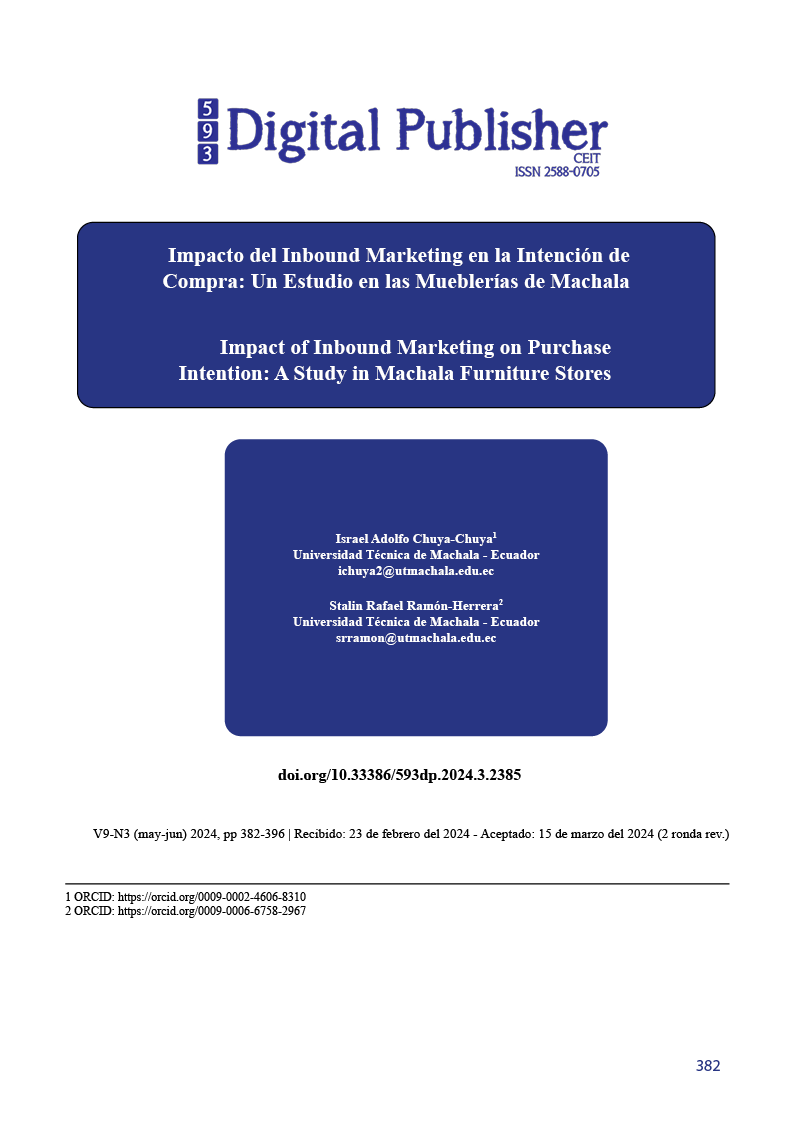Impact of Inbound Marketing on Purchase Intention: A Study in Machala Furniture Stores
Main Article Content
Abstract
Nowadays, the use of digital tools for commercial use is becoming more and more constant, due to the capacity provided by the digital environment to create attractive content to target customers, for this reason Inbound marketing emerges as a digital marketing tool, to meet the need to share information through digital media. In reference to the above, the objective of this research is to analyze the Inbound marketing and its impact on the purchase intention of consumers of furniture products in the city of Machala. The type of research applied was quantitative, with an exploratory scope, investigating the variables that make up the established problem. For data collection, a sample was selected by the non-probabilistic method by convenience to the economically active population of the city of Machala, a survey was determined to a total of 384 people, from 18 to more than 35 years old with 17 items on a 5-point Likert scale. The results showed that the variable of content marketing and direct marketing have a positive influence on Inbound marketing, while establishing a significant and positive relationship between Inbound marketing and the purchase decision. Inbound marketing, by focusing on creating valuable and relevant content to engage customers, leverages content marketing and direct marketing to strengthen its strategy. This approach provides a complete experience that guides consumers in making informed decisions, making it a valuable resource for those interested in products such as furniture.
Downloads
Article Details

This work is licensed under a Creative Commons Attribution-NonCommercial-ShareAlike 4.0 International License.
1. Derechos de autor
Las obras que se publican en 593 Digital Publisher CEIT están sujetas a los siguientes términos:
1.1. 593 Digital Publisher CEIT, conserva los derechos patrimoniales (copyright) de las obras publicadas, favorece y permite la reutilización de las mismas bajo la licencia Licencia Creative Commons 4.0 de Reconocimiento-NoComercial-CompartirIgual 4.0, por lo cual se pueden copiar, usar, difundir, transmitir y exponer públicamente, siempre que:
1.1.a. Se cite la autoría y fuente original de su publicación (revista, editorial, URL).
1.1.b. No se usen para fines comerciales u onerosos.
1.1.c. Se mencione la existencia y especificaciones de esta licencia de uso.
References
Abbu, H. R., & Gopalakrishna, P. (2021). Synergistic effects of market orientation implementation and internalization on firm performance: Direct marketing service provider industry. Journal of Business Research, 125, 851–863. https://doi.org/10.1016/J.JBUSRES.2019.06.004
Aguilar Méndez, D. L., Espinoza Arauz, M. Y., Mera Bravo, E. P., Aguilar Méndez, D. L., Espinoza Arauz, M. Y., & Mera Bravo, E. P. (2022). Análisis del comportamiento de compradores de artículos de expresión social en fechas comerciales. Revista Universidad y Sociedad, 14(1), 484–492. http://scielo.sld.cu/scielo.php?script=sci_arttext&pid=S2218-36202022000100484&lng=es&nrm=iso&tlng=es
Ahmed, N., Li, C., Khan, A., Qalati, S. A., Naz, S., & Rana, F. (2021). Purchase intention toward organic food among young consumers using theory of planned behavior: role of environmental concerns and environmental awareness. Journal of Environmental Planning and Management, 64(5), 796–822. https://doi.org/10.1080/09640568.2020.1785404
Alam, M. N., Ogiemwonyi, O., Alshareef, R., Alsolamy, M., Mat, N., & Azizan, N. A. (2023). Do social media influence altruistic and egoistic motivation and green purchase intention towards green products? An experimental investigation. Cleaner Engineering and Technology, 15, 100669. https://doi.org/10.1016/J.CLET.2023.100669
Al-Surmi, A., Cao, G., & Duan, Y. (2020). The impact of aligning business, IT, and marketing strategies on firm performance. Industrial Marketing Management, 84, 39–49. https://doi.org/10.1016/J.INDMARMAN.2019.04.002
Bablu Thomas, D., & Tamilarasi Professor, S. (2023). THE EFFICACY OF INBOUND MARKETING STRATEGIES ON CUSTOMER’S PURCHASE DECISIONS: AN ANALYTICAL STUDY IN RETAIL SEGMENTS OF KOZHIKODE DISTRICT OF KERALA. Journal of Research Administration, 5(2), 9107–9115. https://journalra.org/index.php/jra/article/view/1019
Baranchenko, Ye., Aksom, H., Zhylinska, O., Firsova, S., & Datskova, D. (2019). Inbound Marketing: Practical Aspects of Promoting Goods and Services in E-commerce. Marketing and Management of Innovations, 4, 308–320. https://doi.org/10.21272/MMI.2019.4-24
Becilla, L., García, A., Steven, J., Torres, U., & Ponce, F. R. (2020). Redes sociales como medio de comunicación publicitaria por emprendedores en la ciudad de Babahoyo periodo Marzo – Mayo 2020. Magazine de Las Ciencias: Revista de Investigación e Innovación, 5(CISE), 370–388. https://revistas.utb.edu.ec/index.php/magazine/article/view/1128
Bigler, T., Kammermann, M., & Baumann, P. (2023). A matheuristic for a customer assignment problem in direct marketing. European Journal of Operational Research, 304(2), 689–708. https://doi.org/10.1016/J.EJOR.2022.04.009
Bueno, S., Caro Rodríguez, J. S., & Gallego, M. D. (2018). Inbound Marketing to improve interest in public postgraduate courses. ESIC Market Economics and Business Journal, 49(3), 533–568. https://doi.org/10.7200/ESICM.161.0493.3
Carpio Maraza, A., Hancco Gomez, M. S., Cutipa Limache, A. M., & Flores Mamani, E. (2019). Estrategias del marketing viral y el posicionamiento de marca en los restaurantes turísticos de la Región de Puno. Comuni@cción: Revista de Investigación En Comunicación y Desarrollo, 10(1), 70–80. https://doi.org/10.33595/2226-1478.10.1.331
Cerda, V. D. C. T., Bárcenas, G. R., Carate, M. D. I., & Matute, V. H. M. (2020). Uso de aplicaciones Web 2.0 para Información de oficina. Revista Publicando, 7(26), 63–71. https://revistapublicando.org/revista/index.php/crv/article/view/2141
Chouaib DAKOUAN, Redouane BENABDELOUAHED, & Hajar ANABIR. (2019). Inbound Marketing vs. Outbound Marketing: Independent or Complementary Strategies - Expert Journal of Marketing. Expert Journal of Marketing. https://marketing.expertjournals.com/23446773-701/
Davidavičius, S., & Limba, T. (2022). Recognition of Digital Content Needs for Inbound Marketing Solutions. Social Sciences 2022, Vol. 11, Page 351, 11(8), 351. https://doi.org/10.3390/SOCSCI11080351
Delgado, S. E., Villacis, W. H. A., & Chávez, A. M. G. (2018). Análisis del comportamiento de compra en servicios intangibles. Revista Universidad y Sociedad, 10(3), 125–133. http://scielo.sld.cu/scielo.php?script=sci_arttext&pid=S2218-36202018000300125&lng=es&nrm=iso&tlng=es
Desai, Dr. Mrs. V. (2019). Digital Marketing: A Review. International Journal of Trend in Scientific Research and Development, Special Issue(Special Issue-FIIIIPM2019), 196–200. https://doi.org/10.31142/IJTSRD23100
Diez-Martin, F., Blanco-Gonzalez, A., & Prado-Roman, C. (2019). Research Challenges in Digital Marketing: Sustainability. Sustainability 2019, Vol. 11, Page 2839, 11(10), 2839. https://doi.org/10.3390/SU11102839
García Mendoza, C., Kishimoto Pinillos, L., Macarachvili, A., García Mendoza, C., Kishimoto Pinillos, L., & Macarachvili, A. (2021). Inbound marketing como enfoque estratégico en el contexto de las Start-ups tecnológicas dirigidas a negocios. Revista Universidad y Sociedad, 13(5), 526–533. http://scielo.sld.cu/scielo.php?script=sci_arttext&pid=S2218-36202021000500526&lng=es&nrm=iso&tlng=es
García-Machado, E., León-Santos, M., García-Machado, E., & León-Santos, M. (2021). ¿Evolución o expansión? Del Marketing tradicional al Marketing Digital. Alcance, 10(26), 37–52. http://scielo.sld.cu/scielo.php?script=sci_arttext&pid=S2411-99702021000200037&lng=es&nrm=iso&tlng=es
Guenther, P., Guenther, M., Ringle, C. M., Zaefarian, G., & Cartwright, S. (2023). Improving PLS-SEM use for business marketing research. Industrial Marketing Management, 111, 127–142. https://doi.org/10.1016/J.INDMARMAN.2023.03.010
Hardyansyah Syihab, B. A., Widayat, W. B., & Rima Fiandari, Y. C. (2023). Estrategias de marketing entrante en aumento de las ventas a vendedores en mercados en línea. Revista Internacional de Revisión de Negocios Profesionales, 8(8), e03100. https://doi.org/10.26668/businessreview/2023.v8i8.3100
Harikrishnan, N. N. J., & Vinith Kumar, N. (2022). A Hybrid Digital Marketing Model based on Content Marketing and Inbound Marketing. Journal for Educators, Teachers and Trainers, 13(4). https://doi.org/10.47750/JETT.2022.13.04.003
Hassan Aljohani. (2020). A Review of Research on Inbound Marketing. Journal for Research on Business and Social Science, 3(4), 1. https://www.jrbssonline.com/volume-3-issue-4-paper-1/
Jara Cerna, K. S., Miranda Guerra, M. del P., Céspedes Ortiz, C. P., Jara Cerna, K. S., Miranda Guerra, M. del P., & Céspedes Ortiz, C. P. (2022). Relación entre el neuromarketing y el posicionamiento de marca de una empresa del sector retail. Revista Universidad y Sociedad, 14(1), 554–563. http://scielo.sld.cu/scielo.php?script=sci_arttext&pid=S2218-36202022000100554&lng=es&nrm=iso&tlng=es
Liu, H., Jayawardhena, C., Osburg, V. S., Yoganathan, V., & Cartwright, S. (2021). Social sharing of consumption emotion in electronic word of mouth (eWOM): A cross-media perspective. Journal of Business Research, 132, 208–220. https://doi.org/10.1016/J.JBUSRES.2021.04.030
Mendia-Valarezo, J. N., Morales-Padilla, E. A., & Moscoso-Parra, A. E. (2022). Uso del social media marketing y el engagement en universidades de Machala. 593 Digital Publisher CEIT, 7(3), 230–243. https://doi.org/10.33386/593dp.2022.3.1082
Mundt Marcia Ross, & Burnett Karen Charla M. (2018). Scaling Social Movements Through Social Media: The Case of Black Lives Matter. Social Media and Society, 4(4). https://doi.org/10.1177/2056305118807911/ASSET/IMAGES/LARGE/10.1177_2056305118807911-FIG1.JPEG
Navia, C., & Jurado, J. L. (2019). Estrategia mejora en el proceso de atracción y mantenimiento de clientes potenciales, mediante el uso de contenidos basados en experiencias de gamificación. Revista Guillermo de Ockham, 17(1), 85–91. https://doi.org/10.21500/22563202.4167
Nisar, T. M., Prabhakar, G., & Strakova, L. (2019). Social media information benefits, knowledge management and smart organizations. Journal of Business Research, 94, 264–272. https://doi.org/10.1016/J.JBUSRES.2018.05.005
Panamá Chica, C. A., Erazo Álvarez, J. C., Narváez Zurita, I., & Mena Clerque, S. E. (2019). El Marketing como estrategia de posicionamiento en empresas de servicios. Dominio de Las Ciencias, ISSN-e 2477-8818, Vol. 5, No. 3, 2019 (Ejemplar Dedicado a: Julio - Septiembre), Págs. 784-802, 5(3), 784–802. https://doi.org/10.23857/dc.v5i3.988
Patel, C. P., & Chugan, P. K. (2018). Digital Inbound Marketing to Drive the Success of Startups. International Journal of Family Business and Management, 2(1), 1–6. https://doi.org/10.15226/2577-7815/2/1/00111
Patrucco, A. S., Marzi, G., & Trabucchi, D. (2023). The role of absorptive capacity and big data analytics in strategic purchasing and supply chain management decisions. Technovation, 126, 102814. https://doi.org/10.1016/J.TECHNOVATION.2023.102814
Purwanti, Y., Erlangga, H., Kurniasih, D., Pratama, A., Sunarsi, D., Manan, A., Imam Duta Waskita, N., Ilham, D., Aditya Dwiwarman, D., & Purwanto, A. (2021). The Influence Of Digital Marketing & Innovasion On The School Performance. Turkish Journal of Computer and Mathematics Education (TURCOMAT), 12(7), 118–127. https://turcomat.org/index.php/turkbilmat/article/view/2551
SALAS, L. C., ACOSTA, M. M., & JIMENEZ, M. E. (2018). Importancia del Marketing de Atracción 2.0, en las Pequeñas y Medianas Empresas de la ciudad de Guayaquil (Ecuador). Revista ESPACIOS, 39(18), 226. https://www.revistaespacios.com/a18v39n18/18391831.html
Sánchez-Teba, E. M., García-Mestanza, J., & Rodríguez-Fernández, M. (2020). The Application of the Inbound Marketing Strategy on Costa del Sol Planning & Tourism Board. Lessons for Post-COVID-19 Revival. Sustainability 2020, Vol. 12, Page 9926, 12(23), 9926. https://doi.org/10.3390/SU12239926
Sarkar, M., & De Bruyn, A. (2021). LSTM Response Models for Direct Marketing Analytics: Replacing Feature Engineering with Deep Learning. Journal of Interactive Marketing, 53, 80–95. https://doi.org/10.1016/J.INTMAR.2020.07.002
Serna, M. (2019). ¿Cómo mejorar el muestreo en estudios de porte medio usando diseños con métodos mixtos? Aportes desde el campo de estudio de elites. Empiria. Revista de Metodología de Ciencias Sociales, 43, 187–210. https://doi.org/10.5944/EMPIRIA.43.2019.24305
Solano-Romo, L. I., Cortés-López, J. S., Bohorquez-Lopez, V. W., & Gómez-Reynoso, J. M. (2022). Entendiendo la adopción de e-marketing en micros, pequeñas y medianas empresas mexicanas. Innovar, 32(85), 19–32. https://doi.org/10.15446/innovar.v32n85.101123
Suárez Cousillas, T. (2018). Evolución del marketing 1.0 al 4.0. Redmarka: Revista Académica de Marketing Aplicado, ISSN-e 1852-2300, n. 22, 2018 (Ejemplar Dedicado a: Relaciones Públicas), Págs. 209-227, 01(22), 209–227. https://doi.org/10.17979/redma.2018.01.022.4943
Tennenbaum, D., Sherman, A., Khurgin, J., & Schulman, A. (2020). 159 Imbalance in Presentation of Risks and Benefits of Penile Enhancement Procedures in Direct-to-Patient Online Marketing. The Journal of Sexual Medicine, 17(1), S49. https://doi.org/10.1016/J.JSXM.2019.11.104
Urbina, N. O. (2021). El proceso de posicionamiento en el marketing: pasos y etapas. RAN - Revista Academia & Negocios, 7(1), 55–64. https://doi.org/10.29393/RAN6-5PPNO10005
Veleva, S. S., & Tsvetanova, A. I. (2020). Characteristics of the digital marketing advantages and disadvantages. IOP Conference Series: Materials Science and Engineering, 940(1), 1–9. https://doi.org/10.1088/1757-899X/940/1/012065
Vidal, C., Povoa, A., Teixeira, I., & Marcos, A. (2021). The New Era of Digital Marketing:Content Marketing and Inbound Marketing. Iberian Conference on Information Systems and Technologies, CISTI. https://doi.org/10.23919/CISTI52073.2021.9476346
Yépez Galarza, G. D., Quimis Izquierdo, N. C., & Sumba Bustamante, R. Y. (2021). El marketing mix como estrategia de posicionamiento en las MIPYMES ecuatorianas. Polo Del Conocimiento: Revista Científico - Profesional, ISSN-e 2550-682X, Vol. 6, No. 3, 2021, Págs. 2045-2069, 6(3), 2045–2069. https://polodelconocimiento.com/ojs/index.php/es/article/view/2492
Yusoff, A. S. M., Peng, F. S., Razak, F. Z. A., & Mustafa, W. A. (2020). Discriminant Validity Assessment of Religious Teacher Acceptance: The Use of HTMT Criterion. Journal of Physics: Conference Series, 1529(4). https://doi.org/10.1088/1742-6596/1529/4/042045
Zhuravskaya, E., Petrova, M., & Enikolopov, R. (2020). Political Effects of the Internet and Social Media. Https://Doi.Org/10.1146/Annurev-Economics-081919-050239, 12, 415–438. https://doi.org/10.1146/ANNUREV-ECONOMICS-081919-050239



